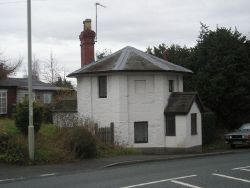Toll house
| Toll House | |
 | |
| Toll House on the old A5 at Montford Bridge near Shrewsbury | |
| Pictures related to Toll house View gallery (17) | |
Toll Houses or Tollhouses are part of the fabric of our main road network that no longer serve the purpose for which they were designed, nor indeed stand out with the prominence they once had. Their origins probably date back to Roman times, when charges, or tolls, were levied on the movement of goods, livestock and people across provincial borders, bridges or along the main roads. The toll collectors needed somewhere to shelter, perhaps live, at the point of collection, and so houses were built. Although these early charges were almost certainly abandoned after the departure of Roman rule, the idea remained current abroad, and was subsequently re-imported in later centuries.
However, it was not until the creation of the first Turnpike trusts in the 17th Century that toll houses became commonplace on our road network. They were provided at the majority of toll gates on the rapidly expanding road networks, and even the government joined in, with toll houses and toll gates on the Holyhead Road built by Thomas Telford in the 1820s. New bridges too were often tolled, with a toll house sited at one side of the other. Only with the coming of the railways did the road building frenzy fade, and as Turnpike trusts collapsed, so roads reverted to the rough dirt tracks of previous generations, until the government stepped in and took over the road network, via the county authorities.
Architecture
Toll houses were often well built cottages suitable for a family to live in, a necessity to ensure that a suitable, honest person was attracted to the role. Often the same design would be built at each tollgate along the roads within a Turnpike trusts area, which makes them more obvious to locals, but as fashions changed, so extensions to local networks might see a different design constructed. The one feature common to the vast majority of the houses was a roadside bay window, or octagonal end to the property to give a good view of approaching traffic. This window would be openable and either open from a proper office or from the main family living room. Tolls were normally collected 24/7, so overnight attendance was also important.
Most toll houses appear to be single storey, but two-storey properties are also found. Almost all, however, were originally built as detached properties, and often surrounded by a patch of land suitable for growing fruit and veg, or housing a few animals to help supplement the toll keepers income.
The presence of these bay windows has often caused problems to subsequent road improvers, as they project into the road itself in places, either forcing a very narrow pavement (when added), or encroaching onto the carriageway until a piece of land opposite could be purchased to allow widening. As a result some bay windows have been taken down, or indeed the whole cottage demolished to allow for improvements. In other places, the cottage sat back from the road, perhaps with just a sentry post on the roadside originally.
Toll houses at bridges were generally built without the prominent bay windows, as they were considered less necessary. Traffic could be much more strictly controlled at a bridge than on a road through open country, meaning less elaborate architecture was required. Many bridge toll houses were connected to the structure itself, and in urban environments, they may extend to no more than a small pavilion built up at one corner of the structure, the toll keepers living in nearby houses. However, in rural areas, a full cottage was normally required.
Toll Houses today
Huge numbers, perhaps thousands, of toll houses remain along our roadsides today. Many have been bypassed by the roads they were built to serve, and consumed by subsequent development, often hiding them away on what we consider to be side roads. Others still stand prominently along the roadside in more rural areas. Many retain their original purpose in their names - Toll House, Turnpike House, Toll Gate House, being some of the more common ones, although Turnpike House may also refer to the headquarters, or another property associated with the trust rather than a toll house.






